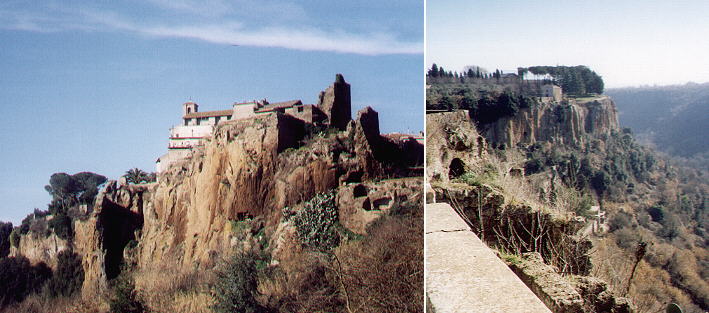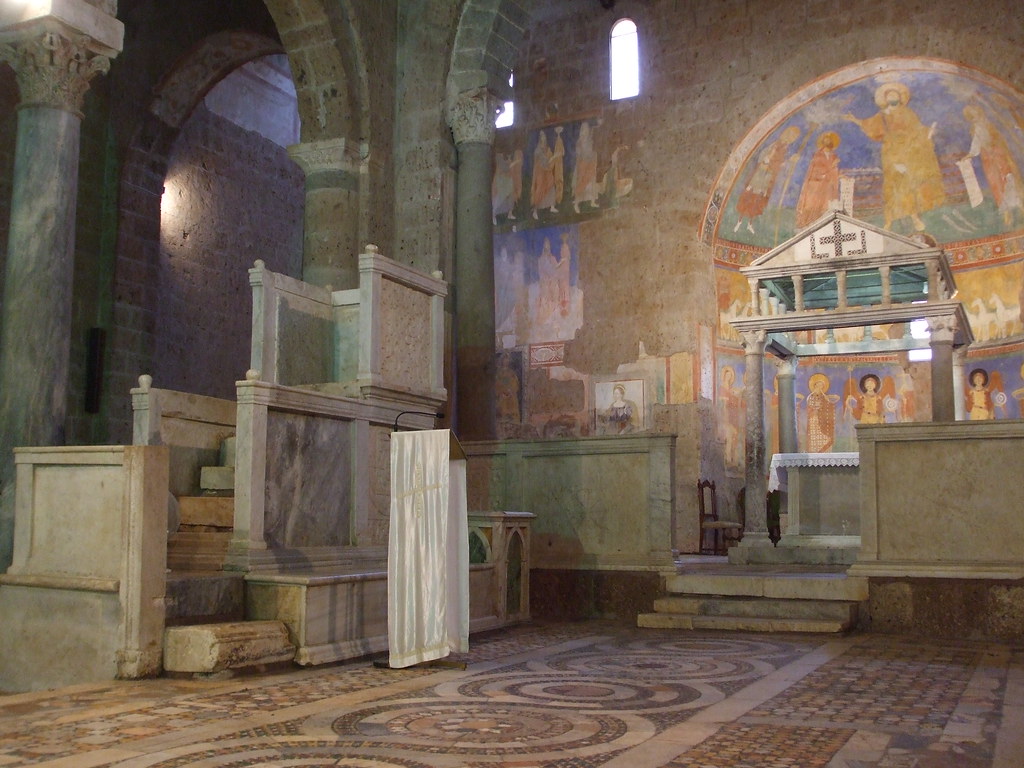Castel Sant'Elia
Castel Sant'Elia is a municipality with 2563 inhabitants ( 31 December 2012) located in the central Italian province of Viterbo, 33 km south of the eponymous provincial capital and 45 km north of Rome. It belongs to the region of Lazio.
Location and Geography
Castel Sant'Elia is located east of Nepi on a communication path between the Roman roads in the West Via Cassia and Via Flaminia in the east. The place is situated on a steep forested in a valley Valle Suppentonia, sloping Tuffplateau.
History
The living and grave caves in the Tuffwand show that the rocky plateau high above the Valle Suppentonia was inhabited Etruscan; these homes were allegedly left in the Roman Empire again as an armored Castrum was built on the plateau.
Critical source area in the phenomenon occurs for the first time to 600 by Pope Gregory the Great. Below the castrum was deep in the forest a company founded by Abbot Anastasius of Suppentonia Benedictine monastery, of which remained only the basilica; the abbot is still revered as the patron saint of the church. In the cave Grotta di San Leonardo, the legendary meeting between the Pope and the Langobardenkönigin Theodolinda to have occurred to the planned invasion of Rome by her husband Agilulf - prevent - which has not taken place at the end.
Since the pippi African gift the land inhabited only by a few shepherds and farmers belonged to the monastery formally the Papal States, but was in reality in the Middle Ages controlled by the local feudal lords ( members of the family Colonna and Orsini ). In the 16th century it took on the Farnese and led on behalf of elsewhere strengthened by wars papal central power in place an effective management system.
Castle and city walls as the center of today's townscape approximately 1.5 km to the west on the plateau only go back to this period. The hamlet grew and took an economic boom; In 1634 he was awarded city status.
Middle of the 17th century, sold the castle to the Farnese Pope Innocent X; a century later acquired the Marchesi of Lezzano today used as the town hall building. The buildings outside the city walls with today's thoroughfare Corso Umberto I ° was only in the 18th century.
Since 1870 Castel Sant'Elia heard how the entire Papal States to the Italian State, since 1927 the province of Viterbo.
Cityscape and Tourist Attractions
There is a difference - due to the local history in its various epochs - basically three different cultural zones:
- The ancient archaeological zone on the plateau, within which also several churches and shrines are located,
- The main town was founded under the Farnese in the 17th century, also on the plateau, but 1.5 km west of the archaeological zone,
- The Basilica of Sant'Elia as a spiritual center of the former Benedictine monastery, standing alone below the Tufffelsens in the woods above the canyon bottom of Valle Suppentonia.
The basilica is art history and main tourist attraction of the community.
The archaeological zone
- Roman ruins and defensive towers of the Castrum are distributed over the entire plateau still be seen; they are called Castelli ( Pizzo Jella, d' Ishi, Porciano, Conversina, Filissano, Paterno ) and were partly used in the Middle Ages. On Paterno died 1002, Emperor Otto III.
- Of the numerous Etruscan caves are two caves as hermits known ( Grotto of Anastasius and Grotto of the Benedictine abbot Nonnoso ). The by Gregory the Great, legendary mentioned Grotta di San Leonardo was fully decorated with frescoes, of which only remnants are visible.
- Nucleus of the local Marie cult is the cave of Santa Maria ad Rupes, in which the Benedictine monks are said to have withdrawn before a miraculous image since the 6th century. Only in the 18th century it was rediscovered by pilgrims. Hermit Andrea Giuseppe Rodio was in the 19th century, a 144 -level access from the plateau down to create the rocks to the cave. Father Giuseppe Bernardo Doebbing in 1892 got involved with a group of Irish Franciscan monks at this point down, a convent built in the entrance area of the staircase, and in 1908 built the still existing church in neo-Gothic style (San Giuseppe ). In 1982, the Franciscans were replaced by Polish monks of the Congregation of the Holy Archangel Michael.
- The miraculous image of the Virgin of the Rocks - which replaces an older fresco - is art historical studies indicate that the school of Giovanni Battista Salvi da Sassoferrato back. It represents Mary is the star robe with crown, hands spreading praying over the static on her lap, as a crowned Christ child. The iconographically unusual presentation was attended by numerous popes, kings and other prominent personalities.
- On the Tuffplateau are still a number of smaller churches, such as the Church of St. Michael ( Roman origins, restored in 1983 ), another St. Mary's Church, which dates back to the 13th or 14th century, Santa Lucia, dated 1656, and Church of St Anthony of Padua (1828 ).
- Between Nepi and Civita Castellana, a paved section of the Via Amerina (3rd century BC ) is apparent at Tre Ponti, a Roman road that ran from Nepi to Gubbio, where she met with the Via Flaminia. It derives its name from the historic town of Ameria, which corresponds to today's Amelia. In the Middle Ages, this road was very important because they constituted the only connection between Rome and the Exarchate of Ravenna. In the rugged rocky landscape still one of formerly three Roman bridges is obtained via two watercourses.
The main town
Oldest buildings of the village are the Farnese castle ( 17th century ) in which the municipality is located today, and the remains of posts originating from the same era city wall with gate zinnenbekröntem.
The parish church of Sant'Antonio in 1740 under Pope Clement XII. built on the ruins of a precursor to the 16th century. The interior is baroque, apart from a Renaissance triptych from the 15th century, Christ enthroned between John the Baptist and John the Evangelist representing that comes from the Basilica of Sant'Elia.
The Basilica
The Benedictine monastery was founded by the local saint Anastasius in Suppentoma ad S. Eliam to 520. Nothing remains of the original system. She was dedicated to the Prophet Elijah; However, namesake of the still existing Roman Basilica of the Benedictine abbot Elias, who built it in the 11th century on the foundations of the precursor. The monastery was founded in 1258 by Pope Alexander IV dissolved and passed to the canons of Santo Spirito in Sassia. As this 1740 built the new church of San Antonio in the main town, the stand-alone investment fell in the forest. 1855 collapsed the Campanile. Still under the pontificate of Pius IX. began the restoration of the Basilica under demolition of the remaining ruinous monastery; This work went on until the early 21st century.
Has the three-aisled basilica on a T-shaped floor plan a simple tuff facade with three arched portals, two single lancet windows above and arched frieze (12th century). The nave (31 meters ) is completed by a transept and a small round apse.
Inside the main and side aisles are divided by marble columns with Corinthian capitals, probably suspected from Roman villas of the environment. Front in the right aisle falls a Lombard Maskenkapitell from the frame.
Kosmatische main pieces of equipment (12th century) are a ciborium in the center of the apse with a cross and four marble columns with Corinthian capitals and a lectern with rich relief decoration in the form of geometric patterns, plants, flowers and birds. Even the marble floor with stylish décor typical thing of the kosmatischen era.
However, Kunsthistorisches main attraction of the basilica are its excellently preserved early Romanesque frescoes in the apse and on the side walls of the transept. They were the brothers Giovanni Niccolò and Stefano Niccolò and their common nephew Giovanni Niccolo, who worked in Rome and around the early 11th century ascribed. Is shown on the apse wall of the Risen Christ between Peter, Paul, and another, not clearly identified biblical figures, possibly Elias and Moses. In the row below twelve lambs symbolize the twelve apostles on the way to the Lamb of God. The bottom row represents a train of virgins with crowns in hand, they (possibly Mary), want to proffer a figure in the middle of the image is destroyed.
The frescoes on the left transept wall was almost completely destroyed by a rockfall in 1607, which hit the basilica. On the right transept wall, the visions of the Apocalypse are shown. Here are scenes from the life of St. Anastasius. From a scene the appearance of the original basilica is still visible.
More frescoes of a later epoch ( 13-14. Century) are attributable, are located on the nave walls.
In the two-aisled crypt with groined vaults, the Holy Anastasius and the Benedictine Abbot of Monte Nonnoso are buried Soratte.
Population
Policy
Bruno Darida ( center-right coalition ) was elected in May 2006 to the mayor. His center-right alliance is with eight out of twelve seats, the majority in the City Council.
Self-understanding, economic and social
Castel Sant'Elia sees itself as a city of art ( città d' arte ). In addition to the preservation of their historic art treasures, the city is keen to also give contemporary painters and sculptors a home; this regularly organize exhibitions in their studios.
In addition, Castel Sant'Elia sees itself as an environmentally friendly city, which at various national programs ( Natura 2000 Network, Bioitaly ) took part. It sets (bars, tavola calda, small retail businesses ). Upon moderate, individually designed with tourism agritourism accommodation in the surrounding area and integration into the local, tailored to the needs of the local infrastructure
The population maintains a rich associational life ( art, music, hunting, fishing, sports, environmental and civil protection, various brotherhoods with social function).
Jobs are available in various ceramics factories and sanitary facilities in the communities along the Via Cassia, between Sutri, Viterbo and Vetralla.
Moreover, the economy of the area is still dominated agrarian with olives and sheep.

__basilica_di_sant_elia_foto_di_m._pesci_(10_2010)(1).jpg)





